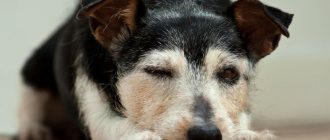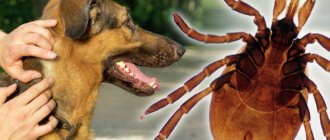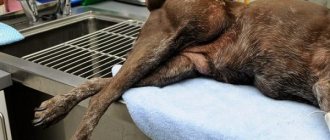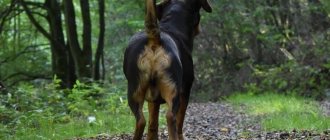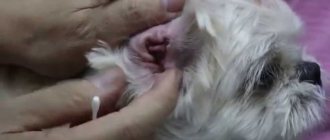- home
- Diseases
»
04/1/2019Diseases
More and more often, our four-legged friends are faced with dental diseases. In veterinary medicine, their combination is called periodontopathy. And one of the representatives of this group is periodontal disease in dogs.
The chewing apparatus plays an important function in the life of mammals. With its help, animals chew food and carry out grasping movements. Sharp fangs and incisors can serve as a way of defense against enemies and rivals. Inflammatory processes in the jaw interfere with the pet’s normal lifestyle.
With periodontal disease, the entire periodontium (tissue complex) is affected.
It spreads exclusively in a generalized manner and is divided into acute and chronic. The disease is divided into 3 stages:
- light,
- average,
- heavy.
It is noteworthy that she does not have significant symptoms of inflammation in the periodontal pockets (the space between the tooth and the gum). The same feature applies to the gingival margin (the area of the gum that is adjacent to the incisor).
Causes
The main factor provoking the occurrence of periodontal disease and other destructive effects of the oral cavity is an incorrectly formulated diet. When soft food predominates, the jaws do not receive the proper load and gradually weaken.
Plaque has already appeared on the teeth
Plaque settles on the incisors and turns into tartar. But too much hard food also poses a danger: the dog can damage its gums or incisors, which will cause inflammation.
Researchers in the field of veterinary medicine believe that breed plays a significant role. Experts are confident that individuals with physiological characteristics of the structure of the head and body are most prone to periodontopathy. The lower the total weight, the greater the likelihood of dental damage. But with a large body weight, periodontal lesions can be traced.
After a series of experiments, scientists identified 3 main causes of oral pathologies:
- structural features;
- improper conditions of detention;
- changes in oral homeostasis (microflora).
Chihuahuas are most susceptible to developing periodontal disease.
Some veterinarians are of the same opinion: they believe that brachycephalics and dogs of such breeds as boxers, pugs, bulldogs, etc. are prone to periodontal disease. Others note that the diagnosis is registered in 100% of cases in older toy breeds, especially Chihuahuas.
Influence of place of residence
It has been proven that dogs living in rural areas are least susceptible to damage to the gums and incisors. Village pets are fed mainly low-calorie, coarse food. Moreover, almost all individuals look the same: average size, outbred and normal (mesocephalic) muzzle structure.
A different situation is observed in urban life. Even in rural animals, after urbanization, degenerative processes of molars begin to develop. This is explained by changes in the level of oral homeostasis at the new place of residence.
Causes of periodontal disease
If there is no proper care for the animal, this leads to a number of problems. One of them is periodontal disease in dogs - this is a disease of the oral cavity, or rather inflammation of the periodontium. Periodontal disease appears in dogs for very trivial reasons - tartar, due to lack of manual brushing of teeth or solid food. But tartar itself, as such, is not the main cause of periodontal disease, it is only the root cause.
But its rough surface, which attaches microbial plaque to itself, is the global cause of periodontal disease. An increase in tartar leads to the immutability of baby teeth, malocclusion, decreased chewing process, and a lack of oral hygiene in the dog.
It should be noted that the outer part of the teeth is more often affected by periodontal disease than the inner part, and the upper teeth are more prone to this disease than the lower ones. This is especially true for the upper canines. Tartar appears on them first and then spreads over the entire surface of the teeth. It develops independently and consequently leads to complete loss of teeth and even jaw fractures.
Development of the disease
The disease develops in the following stages:
- First, plaque forms;
- if the dog’s teeth are not cleaned of plaque with a brush or hard food, then it mineralizes and turns into tartar;
- bacteria settle and multiply under the gums and gingivitis forms;
- in the gums, bacteria accumulate in the deeper layers of tissue and destroy the roots of the teeth, which leads to their loss.
Bacteria that cause disease accumulate inside the root system of the teeth, enter the bloodstream and spread throughout the body. As a result, they destroy the liver, kidneys and heart from the inside. This significantly shortens the dog's lifespan.
Symptoms
Periodontopathy tends to gradually “capture” the entire oral cavity. Lack of hygienic care for the incisors leads to the appearance of plaque on which bacteria settle. At some point, there are so many microorganisms that natural defense mechanisms can no longer cope with the constant onslaught. This is how a focus of inflammation arises.
Plaque is visible to the naked eye
The main symptoms of periodontal disease in dogs are:
- change in preferences - the pet does not want to eat solid food because it experiences pain;
- aggressive reaction to touching the jaw;
- unpleasant odor from the mouth;
- redness of the gums;
- increased salivation, often staining saliva pink;
- the dog intensively “scratches” its muzzle with its paws;
- unsteadiness of teeth, up to their loss;
- flux;
- abscesses and oronasal fistulas.
Weakness of the canines or incisors indicates a neglected condition.
Unfortunately, the primary signs (when it is possible to preserve the dentition) remain out of sight of the owner. Destruction begins in the internal tissues of the gums, so it is quite difficult to determine the disease without diagnosis. Therefore, owners notice changes when the molars become very wobbly.
Clinical picture of periodontal disease
The disease mainly affects most pets whose diet lacks solid food. The life expectancy of four-legged pets with periodontal disease is less than that of dogs with a healthy oral cavity. That is why, if you notice signs in your dog that indicate the development of periodontal disease, you should immediately take measures to eliminate it.
Symptoms of the disease:
- putrid odor from the mouth;
- inflamed red gums;
- painful sensations when pressing on the gums;
- salivation, with saliva often colored pink due to bleeding;
- refusal to eat due to painful sensations when chewing;
- loose and falling teeth;
- swelling of the facial muscles;
- fistulas, abscesses in the mouth (in severe cases).
The signs are quite clear, so identifying the disease at home is not particularly difficult. However, the onset of structural damage to bone tissue can only be detected using diagnostic measures (one of the mandatory ones is radiography) in a clinical setting.
Treatment
The course of recovery depends entirely on the condition of the dog’s periodontium. If the source of inflammation has not yet affected the bone tissue, the veterinarian applies conservative treatment. First, he carries out ultrasonic cleaning to remove plaque and other deposits. Next, it stops the degeneration with antibiotic drugs. Additionally, mouth sanitation is prescribed.
The doctor must examine the patient
The therapy is entirely aimed at preserving healthy molars. But if the pet is diagnosed with mobility of some incisors, they are removed. Along with surgical intervention, the specialist removes all purulent accumulations, preventing inflammation from spreading further.
Filling is practiced in European countries, but in Russia this method is not used.
During treatment, the patient is prescribed a strict diet. In most cases, this is veterinary food, the granules of which have an optimal degree of hardness. Simply put, they are not too hard and not too soft. The duration of the diet is determined by a veterinary dentist.
Below is a list of medications that are used to control periodontal disease in dogs. Please note that the table is for informational purposes only. You should not self-medicate - this can be an additional blow to your pet’s body!
| Name | View | Country of origin | Average cost in Russian rubles |
| 8 in 1 Dental Breath Tabs | Pills | USA | 300-700 |
| Dental Pet Spray | Spray (with toy) | Italy | 300-500 |
| Dentavedin | Gel | Russia | 60-100 |
| Nibbler Cristal Line | Gel Spray | Russia | 100-300 200-400 |
| Products of Hartz Mountain Corporation | Pastes Brushes Records | USA | 100-400 |
How to help at home
The owner must maintain the oral hygiene of his four-legged friend. For this, special toothpastes, gels or sprays are used. Additionally, it can treat inflammation areas with disinfectants. Chlorhexidine 0.05% and Miramistin 0.01% are suitable as an antiseptic.
Useful chamomile decoction
Among folk remedies, decoctions of sage, chamomile, calendula, and propolis are widely used. An alternative option is Yoddicerin.
Complications and prognosis
Lack of proper treatment leads to tooth loss and the spread of the inflammatory process to the skull. The earlier the disease was noticed, the greater the chances of stopping it and saving all the incisors.
The situation becomes more complicated in advanced stages. If periodontal disease becomes chronic, there are often cases of associated ailments. One of these is osteosclerosis, in which thickening of the tooth bone occurs. Its opposite is osteoporosis. It is characterized by a decrease in bone density. Both are clearly visible on x-rays. In the first case, there is a decrease in the transparency of the affected area, in the second - its increase.
Later, destruction begins - destruction of the bone. Instead of tissue, a tumor or accumulation of pus appears. With atrophy, there is a general decrease in the tooth bone.
Briefly about the main thing
- Periodontal disease is a non-inflammatory disease of periodontal tissue.
- The main cause of the disease is the appearance of bacteria due to tartar.
- Periodontal disease and periodontitis are different diseases and, accordingly, require different treatments.
- The treatment is complex, prescribed only by a doctor.
- With improper treatment or lack thereof, sepsis can develop, which can lead to death.
- All dogs are at risk, but Chihuahuas are most susceptible.
- With proper dental care, disease can be prevented.
Prevention
The most important preventative measure is regular cleaning of molars. The recommended number of procedures is at least 1-2 times a week. If necessary, hygienic cleaning is carried out daily. Pastes, brushes, sprays and other means are used for this.
It is very important to inspect your dog's mouth daily. If plaque appears on the incisors, it should be removed immediately. Otherwise, it will accumulate until it turns to stone. It is much more difficult to get rid of it.
Proper nutrition significantly reduces the risk of periodontal inflammation. The owner should not give preference only to soft food for the pet. To create stress on the jaw, the dog must regularly eat special treats (Dental) or chew on toys.
Periodontopathy is considered one of the most commonly diagnosed diseases in veterinary medicine. This is due to improper feeding, in which the dog has no load on the incisors. To prevent the development of inflammation, the owner must regularly carry out oral prophylaxis.
Causes of the disease
The main factors causing such oral pathology in dogs should be considered:
- Food debris that forms plaque on teeth. They are one of the most “popular” causes of the disease.
- Fungi and viral infections. Once in a favorable environment, they multiply intensively, causing many different diseases, including periodontal disease.
- Vitamin deficiency, a decrease in the protective functions of the immune system against the background of other ailments.
- Breed affiliation. Dogs of brachycephalic breeds - pugs and bulldogs - fall into a special risk zone.
